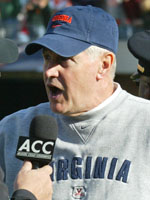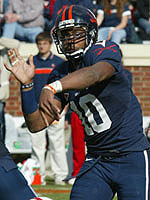 |
|
Al Groh obviously wants spring practice to be productive for the team. |
Virginia’s Al Groh was asked on Tuesday what he wants to get out of spring practice and what factors he looks at in evaluating the success of the spring. The seven-year head coach took a measured pause to gather his thoughts, before giving a thoughtful answer:
“That we truly gain experience,” Groh said. “Some players play three years and they get three years’ experience. Some players play three years and they get one year’s experience three times.”
That’s why any head coach wants the spring practice period to be a time of increased understanding and familiarity with the game and the schemes. It’s such a short few weeks, the time could easily slip away if not planned and used effectively. However, if players and coaches put together a focused and dedicated series of practices, the spring can be one of the most beneficial times of the year.
No one wants wasted time. So can the players develop quickly through repetitions and build on their experience day to day, practice to practice, snap to snap? Can the team start laying the foundation for the chemistry needed on and off the field for fall success? In many ways, spring practice is about answering those types of questions.
“As some of these situations present themselves in practice, whether its this blitz you’ve got to block, that pattern you’ve got to cover, does it click? ‘Oh yeah, I’ve seen that before.’ Can a player handle it?” Groh said. “Has this newly put together group of players come together? How do they buy into each other? How do they buy into the objectives?”
Beyond these philosophical ponderings, however, the key on-field element boils down to execution. Can you as a player do what you’re supposed to do in a given scenario – and can you do it consistently? If so, you’ll like find your way into the rotation and as a contributor to team success. That’s the piece of the puzzle the coaches are watching closely as more players get more chances in the spring.
“Then, very simply performance,” Groh said. “It’s very simple; we tell the players all the time ‘All we can go on is what we see.’ There’s no mystery to it. There are no crystal balls, no hocus pocus. Just watch the practice, watch the tape. That’s what we know.”
The team opens practice Wednesday at 4 p.m. at the U-Hall practice fields. The practice is open to the public. Other open practices include March 24 (Saturday) at 11:45 a.m., March 25 (Sunday) at 2:45 p.m., and April 7 (Saturday) at a time to be determined.
Of course, one of the big questions entering the spring practice period is the health of quarterback Jameel Sewell , who had wrist surgery in the offseason on his throwing wrist. Sewell took over the starting QB job during the season last fall and started the final nine games after working mostly as the No. 2 or No. 3 quarterback throughout the spring and fall practice periods. Going through the spring as No. 1 this time around would help his development through repetitions.
 |
|
Jameel Sewell ‘s level of participation this spring has yet to be determined. |
Other players that may be at least somewhat limited in spring drills are receiver Kevin Ogletree (wrist), linebacker Clint Sintim (shoulder), and linebacker Denzel Burrell (knee). Ogletree is expected to be near 100% in participation, while Sintim and Burrell will be at least somewhat limited in order to protect their continuing rehabilitation. Sewell will be a day to day decision, especially since he has “only thrown nerf footballs” since his surgery and his full rehab progress hasn’t been tested in football practice yet.
“Quite clearly, the principle party here is Jameel Sewell , who had wrist surgery shortly after the season. It was on his throwing wrist. For all the upbeat feelings that we have about the team, obviously that is a big issue,” Groh said. “As we have discussed before, college football has become to a degree an offensive game and such a quarterback driven game. At this point last year we went into the spring with really no experience at quarterback, and now we have a player with a substantial amount of experience at the position but with another question mark hanging over his head. It’s not so much that he is inexperienced but what his participation and progress will be. I think each practice will determine how much of that he can take.”
Does it concern Groh that Sewell may not be ready to fully participate and that the effects could linger?
“I think any time a quarterback’s passing arm has been surgically repaired, until he’s thrown his fastball again, it’s always a question,” Groh said.
(Make sure to pick up a Sabre Edge subscription for the spring because The Sabre provides top notch spring football, baseball, lacrosse, and tennis coverage. Edge subscribers get exclusive analysis, game coverage, photos, and more!)



